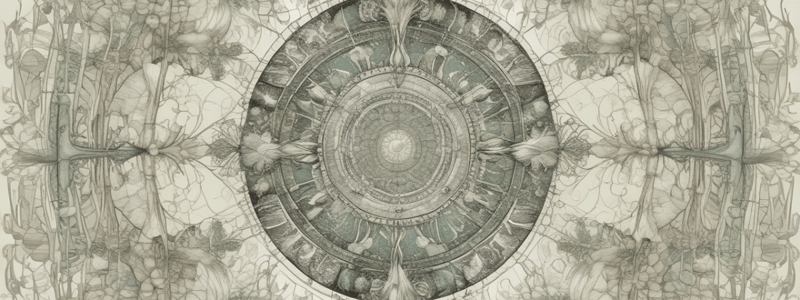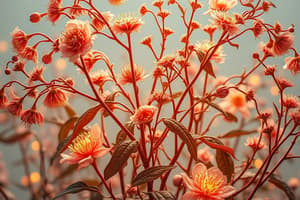Podcast
Questions and Answers
What is the term for a physical response to the length of day versus the length of night?
What is the term for a physical response to the length of day versus the length of night?
- Photoperiodism (correct)
- Day-length response
- Circadian rhythm
- Sleep/wake cycle
What is the primary response influenced by photoperiods in plants?
What is the primary response influenced by photoperiods in plants?
- Stem elongation
- Leaf growth
- Root development
- Flowering (correct)
What is the critical length in regards to photoperiodicity?
What is the critical length in regards to photoperiodicity?
- The length of daylight a plant requires to grow roots
- The length of daylight a plant requires to sleep
- The length of daylight a plant requires to produce flowers (correct)
- The length of daylight a plant requires to photosynthesize
How do plants monitor the amount of light?
How do plants monitor the amount of light?
What can influence the critical length of a plant?
What can influence the critical length of a plant?
What type of plants require a specific day-length condition to flower?
What type of plants require a specific day-length condition to flower?
How many days of meeting the critical length requirements are needed for some plants to flower?
How many days of meeting the critical length requirements are needed for some plants to flower?
What do plants use to monitor light?
What do plants use to monitor light?
What happens to a plant's flowering if the dark period is interrupted, even for just a minute?
What happens to a plant's flowering if the dark period is interrupted, even for just a minute?
What is the characteristic of short-day plants?
What is the characteristic of short-day plants?
When do short-day plants tend to flower?
When do short-day plants tend to flower?
What is an example of a long-day plant?
What is an example of a long-day plant?
What happens to a plant's flowering if the light period is interrupted, for example, if it's dark for a minute?
What happens to a plant's flowering if the light period is interrupted, for example, if it's dark for a minute?
What is the characteristic of day-neutral plants?
What is the characteristic of day-neutral plants?
What can growers regulate to control when plants will flower?
What can growers regulate to control when plants will flower?
Flashcards are hidden until you start studying
Study Notes
Photoperiodicity
- Photoperiodism is a physical response to photoperiods, which is the length of day versus the length of night.
- Plants have a daily cycle influenced by sunlight and darkness, affecting aspects such as flowering.
Critical Length
- The critical length is the length of daylight a plant requires to produce flowers.
- Some plants require only one day of critical length to flower, while others need weeks.
- Critical length can be influenced by temperature and location.
Photoreceptors
- Plants have specialized cells called photoreceptors that monitor the amount of light.
- Photoreceptors help the plant determine the correct time to flower.
- Plants are more sensitive to the length of darkness than the length of sunlight.
Effects of Darkness Interruption
- If the dark period is interrupted, even for a minute, the plant will not bloom, even if the critical length of sunlight is met.
- If there's an interruption in the light period, the plant will continue to flower according to its regular requirements.
Types of Photoperiodic Plants
Short-Day Plants
- Short-day plants require a light period shorter than the critical length.
- Examples: poinsettias, strawberries, and primroses.
- Tend to flower in early spring or fall when daylight is shorter.
Long-Day Plants
- Long-day plants require a light period longer than the critical length.
- Examples: spinach, lettuce, and henbane.
- Tend to flower in the summer when daylight is longer.
Day-Neutral Plants
- Day-neutral plants do not have a critical length and are not affected by daylight length.
- Examples: cucumbers, sunflowers, and rice.
- Will flower regardless of the amount of sunlight per day.
Studying That Suits You
Use AI to generate personalized quizzes and flashcards to suit your learning preferences.




